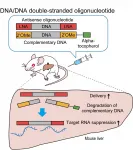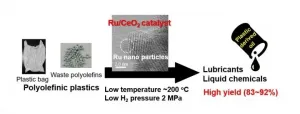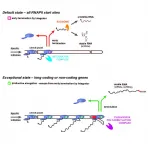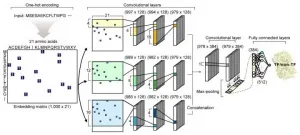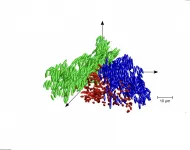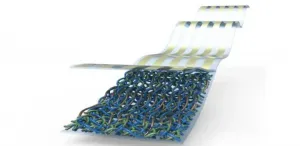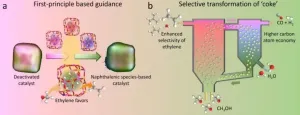Viewing upper gastrointestinal cancers in a new light
2021-01-05
(Press-News.org) Researchers from Tokyo Medical and Dental University (TMDU) describe an endoscopic modality for detecting upper gastrointestinal tract neoplasms by Linked Color Imaging that innovatively mixes light of different wavelengths to better depict mucosal changes
Tokyo, Japan - Recently there have been significant advances on several fronts in the ongoing war against cancer of the alimentary tract. Now, Japanese researchers report the development of another weapon: Linked Color Imaging (LCI), a novel endoscopic technique that improves detection of cancer by viewing the upper digestive tract mucosa under illumination that combines specific wavelengths of light to intensify subtle color variations indicative of neoplastic change.
Upper gastrointestinal (GI) endoscopy is routinely performed to detect tumorous changes or neoplasia in the pharynx, esophagus, and stomach and is conventionally done under White Light Imaging (WLI). Using the innovative LASEREO system developed by the Fujifilm Corporation, LCI technology balances white light with narrow-band short wavelength light in a specific ratio that deepens and enhances the contrast of red and white hues, thus intensifying nuances of mucosal transformation.
Though earlier studies have described the role of LCI in histological diagnosis of upper GI tract tumors, the research team felt the need for a large-scale, broad-based comparative study to assess its efficacy in neoplasm detection. "Our research was conducted in 19 hospitals across Japan involving 1502 patients with known past or current gastrointestinal cancer, representing a high-risk population" explains Dr Shoko Ono, lead author. "Patients underwent upper GI endoscopy under both WLI and LCI protocols wherein they were grouped according to which modality was performed first. Ingeniously, our study design ensured diagnostic accuracy; not only did each modality serve as a backup and crosscheck on the other, this was further followed by histopathological confirmation."
Dr Kenro Kawada, co-lead author, describes the results. "With LCI, lesions were detected in 8% of the patients but the detection rate was only 4.8% with WLI. Conversely, with WLI 3.5% of patients had a lesion overlooked but this rate was only 0.67% with LCI. This shows a clear superiority of LCI over conventionally illuminated endoscopic screening for discerning mucosal changes related to upper GIT neoplasia as it detected neoplasia 1.67 times more frequently."
Professor Mototsugu Kato, senior and corresponding author, explains the implications of their research. "Combined with previous studies that show the efficacy of LCI in detecting large intestinal neoplasia, our findings make a strong case for wider adoption of this modality in surveillance of the entire endoscopically accessible digestive tract. However, we need further research to confirm its efficacy in the hands of general clinicians for upper GI screening of an average population."
INFORMATION:
The article, "Linked Color Imaging Focused on Imaging for Neoplasm Detection in Upper Gastrointestinal Tract (LCI-FIND): a randomized trial" was published in Annals of Internal Medicine. at DOI: 10.7326/M19-2561
[Attachments] See images for this press release:
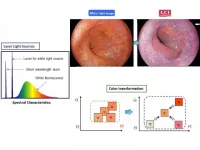
ELSE PRESS RELEASES FROM THIS DATE:
2021-01-05
Researchers from Tokyo Medical and Dental University (TMDU) and Ionis Pharmaceuticals, USA, report a modification wherein replacing the RNA strand of a heteroduplex oligonucleotide with DNA may enhance the efficacy of antisense oligonucleotide-based drugs
Tokyo, Japan - Antisense oligonucleotides (ASO) hold great promise for pharmacotherapy. Now, researchers at Tokyo Medical and Dental University (TMDU) and Ionis Pharmaceuticals, advancing their earlier work on a heteroduplex oligonucleotide (HDO) model, have demonstrated augmentation of ASO-based ...
2021-01-05
For the first time, researchers have used a novel catalyst process to recycle a type of plastic found in everything from grocery bags and food packaging to toys and electronics into liquid fuels and wax.
The team published their results on Dec. 10 in Applied Catalysis B: Environmental.
"Plastics are essential materials for our life because they bring safety and hygiene to our society," said paper co-authors Masazumi Tamura, associate professor in the Research Center for Artificial Photosynthesis in the Advanced Research Institute for Natural Science and Technology in Osaka City University, and Keiichi Tomishige, professor in the Graduate School of Engineering in Tohoku University. "However, the growth of the global ...
2021-01-05
An imbalance of the body's oxygen producing free radicals and its antioxidant cells could be the reason why gum disease and chronic kidney disease affect each other, a new study led by the University of Birmingham has found.
Periodontitis - or gum disease - is a common, inflammatory disease which causes bleeding gums, wobbly or drifting teeth and can eventually result in tooth loss.
Previous studies have shown a link between the severe oral inflammation caused by gum disease and chronic kidney disease (CKD) which demonstrated that those with worse inflammation of the gums have worse kidney function.
Previous research also showed that patients with CKD and periodontitis experience ...
2021-01-05
Practicing gratitude and looking to the future will help safeguard our mental wellbeing during Covid-19 lockdowns, a new study in the Journal of Positive Psychology reports.
In the first study of its kind, researchers from the University of Surrey investigated the effectiveness of three psychological interventions -- nostalgia, a sentimentality for the past; gratitude, recognising the good things currently in our life; and best possible self, thinking about positive elements of the future -- and how they each affect wellbeing during lockdowns.
Personal characteristics such as emotion regulation (the ability to respond ...
2021-01-05
In a joint collaboration, Danish and German researchers have characterized a cellular activity that protects our cells from potentially toxic by-products of gene expression. This activity is central for the ability of multicellular organisms to uphold a robust evolutionary 'reservoir' of gene products.
Manufacturing processes need quality control systems in order to ensure proper assembly of functional products. Moreover, space-consuming, and perhaps even toxic, by-products of such processes need to be properly discarded or recycled by efficient waste handling systems.
By analogy, transcription of our genome is an imperfect process that produces large quantities of non-functional and potentially harmful transcripts both from within and ...
2021-01-05
Researchers at the Francis Crick Institute and the University of Western Australia have developed a new imaging method to see where antibiotics have reached bacteria within tissues. The method could be used to help develop more effective antibiotic treatments, reducing the risk of antibiotic resistance.
During bacterial infections like tuberculosis, bacteria enter human cells, which poses a challenge for treatment, as antibiotics must reach and enter all infected cells in order to be effective. If researchers could select for or develop more effective antibiotics based on where they reach, this may reduce the length of treatment ...
2021-01-05
A joint research team from KAIST and UCSD has developed a deep neural network named DeepTFactor that predicts transcription factors from protein sequences. DeepTFactor will serve as a useful tool for understanding the regulatory systems of organisms, accelerating the use of deep learning for solving biological problems.
A transcription factor is a protein that specifically binds to DNA sequences to control the transcription initiation. Analyzing transcriptional regulation enables the understanding of how organisms control gene expression in response to genetic or environmental changes. In this regard, finding the transcription factor of an organism is the first step in the analysis ...
2021-01-05
While glass is a truly ubiquitous material that we use on a daily basis, it also represents a major scientific conundrum. Contrary to what one might expect, the true nature of glass remains something of a mystery, with scientific inquiry into its chemical and physical properties still underway. In chemistry and physics, the term glass itself is a mutable concept: It includes the substance we know as window glass, but it may also refer to a range of other materials with properties that can be explained by reference to glass-like behaviour, including, for instance, ...
2021-01-05
Sunlight offers a potential solution in the search for an energy source that does not harm the planet, but this depends on finding a way to efficiently turn electromagnetic energy into electricity. Researchers from KAUST have shown how a known herbicide can improve this conversion in organic devices.
While solar cells have traditionally been made from inorganic materials such as silicon, organic materials are starting to break through as an alternative because they are light, flexible and relatively inexpensive to make, even offering the possibility for ...
2021-01-05
MTO process, which was first commercialized in 2010, is a catalytic process converting methanol, which is typically made from coal, natural gas, biomass, and CO2, over SAPO-34 zeolite catalyst. It's becoming one of the main streams for producing light olefins, including ethylene and propylene, from non-oil resources.
One of the major challenges in MTO is the rapid deactivation of zeolite catalyst due to the coke deposition.
In industrial practices, a fluidized bed reactor-regenerator configuration is normally used in order to maintain the continuous operation, in ...
LAST 30 PRESS RELEASES:
[Press-News.org] Viewing upper gastrointestinal cancers in a new light

